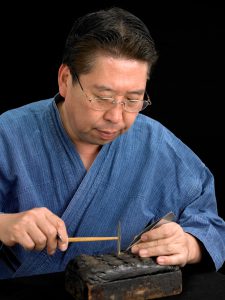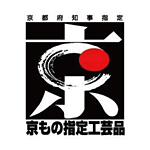象嵌(Damascene)

金工布目象嵌は、特殊鋼板に純金を嵌入する京都伝統工芸の手工芸です。
起源は随分古く紀元前ペルシャ王朝が華やかだった頃既に武器などに加工され、愛用されていました。
我が国へは古墳時代、中国から伝来し、武具の装飾にその技術が用いられていました。殊に幕末諸国の武士が京都に集まり、この技術を施した刀のつばが高評でしたが、明治九年の廃刀令の後、その技術を身具に用い、利用面を拡大、その渋みと、高雅な品格が、高く賞揚されています。
象嵌の作り方
- 生地の表面に鏨を用いて、窯角溝を刻みます。
- 純金(K24)・純銀(PURE SILVER)の線や平金をその上に置き、模様を象りながら打ち込んでいきます。
- 薬品で洗って鉄の表面を腐食させます。
- アンモニアで、錆を出し、上茶で煮て錆止めをして、数回、漆を塗っては焼き、表面を真黒にします。
- 模様の上を朴炭で擦り、先に打ち込んだ金銀を研ぎ出し、研ぎ出した金銀の模様に毛彫りをして仕上げます。
DAMASCENE
In the fifth to sixth century, Line Damascenes had been manufactured vigorously in Mosul, Iraw, where is by the up stream of Tigris.
The technique of the Line Damascene was brought to japan along with Buddhism through Silk Road. However,Damascus, Syria, where was center of culture in the twelfth century, is recognized as cradie of the Nunome(blanket texture pattern) Damascene, which is a major technique of making damascene today. This technique was introduced into Japan through China and Korean Peninsula, and it was held in high esteem as a guard of a sworfm armor, and ritual article.
Nowadays, this historic technique is used for accessories and omaments.
Process of making.
- The fine lines of the design are first engraved into the iron base with delicate chisels.
- Wires on pure gold and silver are then inlaid into the base to from the completed design.
- Next the surface is washed in nitric acid to make it smooth and flat
- The piece, is then immersed in ammonia to develop a patina and finally voiled in green tea to finish the pattination. Many coats of lacquer are the baked on until a pure black surface is developed.
- The lacquer is then stripped off with a steel bumisher just enough to expose the complete gold and silver design. The entireplece is then polished with charcoal to a finished luster and the gold and silver areas are engraved with hairline cuts to complete the finished plece.
※「京象嵌」は協同組合 京象嵌協会から、特許庁の地域団体商標に登録されています。
※「京象嵌」は、京都府知事指定伝統的工芸品(京もの指定工芸品)に指定されています。

七宝焼(Cloisonne)

七宝焼は、銅、銀、金などの、素地に七宝釉薬といわれる、様々な色に発色する特殊なガラス質を焼き付けて作る工芸品です。
仏典にある七宝(金・銀・瑠璃・蝦蛄・瑪瑙・真珠・ま・瑰)に匹敵するほど、美しいとされたことから、その名が付けられました。
古くは、古代ペルシャやエジプトの時代にもあったとされる七宝の技術ですが、日本では、江戸後期に日本独自の技術が完成。そして、明治以降京都では、新たに技術が革新し、職人の繊細華麗な技巧とあいまって、その美しさは、国内外問わず高い評価を得ることとなりました。
七宝の作り方
- 素地は銀か銅を使用し、形を作ります。
- 構図を描き、純銀の細かい線で模様を形取り焼付けます。
- 釉薬(色ガラスの粉を原料とする)を彩色し、電気炉(850℃)前後で4~5回、窯焼きします。
- 表面を研磨する場合は荒砥から、仕上げ砥ぎまで、約9種類の砥石を使用します。
- 研磨しない場合は、銀線を覆う厚さになる様、全体に数回透明釉薬を焼付けます。
CLOISONNE
about 120 years ago.There in the old city the art of making “Cloisonne” ware has been kept for many years.The Japanese word for Cloisonne ware is Shippo or Seven Treasured ware. Originally the ware was done by inlaying seven different precious treasures such as Sapphires, Emeralds, Corals, Jades, Cobalt, Crystals and Pearls, etc., and these ware mounted in gold and silver. In the created process enamels take the place of these precious stones.
Cloisonne making was originated in Central Asia. The art came to Japan with Buddhism in about 538, and was developed to the present style in the Edo period(1600-1860)
Every piece of Cloisonne ware is made by hand by skilled craftsman, in the following process:
- Foundation – copper, silver or gold.
- Drawing design on the foundation.
- Wires affixed on the design, stuck by glue temporarily.
- Solder enamel flux is dropped in.
- First baking for soldering wires.
- First coating of enamels.
- Second baking at about 850 degree C.
- Second coating of enamels.
- Third baking.
- Third coating of enamels.
- Fourth baking, by this time enamels get thick enough to cover all wires.
- Polishing by 9 different whetstones.
- Finish and trimming done with silver and or gold
※「京七宝」は京七宝協同組合から、「特許庁の地域団体商標に登録されています。
※「京七宝」は、京都府知事指定伝統的工芸品(京もの指定工芸品)に指定されています。
※「京七宝」は、京都市長指定京都市伝統産業に指定されています。
